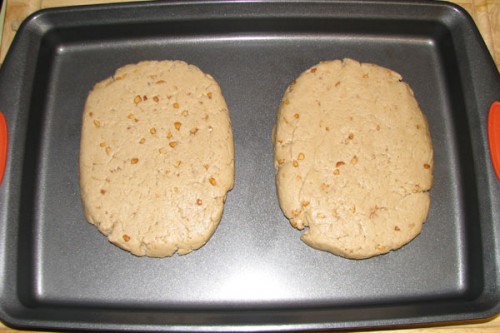Coon Dog Training
1Begin training your dog with basic commands such as sit, stay and heel. Use a system of positive reinforcement through dog treats, petting and verbal praise to encourage obedience in the dog. The dog must first learn to obey you in general before he can learn to hunt raccoons.
2Choose a command for entering your car, such as “load up” or “get in.” Train the puppy to go to your car or truck and to be comfortable in his dog box or in the back of your vehicle. The more comfortable the dog becomes with transportation, the more prepared he will be for the hunt.
3Lay artificial scents in areas of your yard or small wooded areas. Encourage your dog to follow these scents; this will get him used to the scent of a raccoon, as well as give him practice following trails. Reward the dog for following the scent properly.
4Use an old coon hide to teach your dog what the raccoon looks like. Drag it in front of the dog as he chases it so that he gets used to following the raccoon. Hang the hide from trees so that the dog gets used to staying with the raccoon even after it climbs. Reward the dog for following and pursuing the coon hide.
5Arrange for your new coon dog to go on hunts with experienced raccoon hunting dogs. The younger animal will mimic the experienced dog’s actions and abilities and will pick up a lot of techniques from the older dog.
How to Stop Dog Jumping
In January, Petfinder held a live Q&A on Facebook with pet trainers Andrea Arden and Mychelle Blake. Over the coming weeks we’ll be posting some of our favorite questions and answers here on the blog. Have a pet question? Check back regularly for news about our next live Q&A!
Q: How can I stop my dog from jumping whenever I put my jacket or sweatshirt on? She thinks she’s coming with me every time I leave the house. –Stacey B.
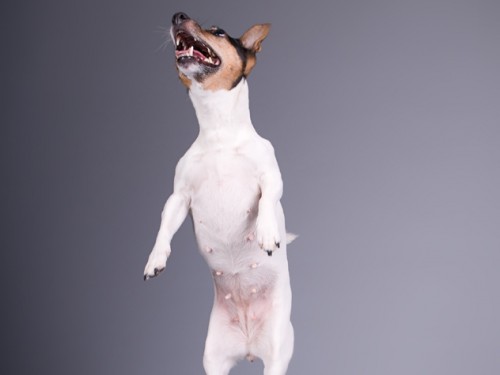
With any behavior issue, the first step is identifying the cause (we just did that!) and the second is using management to prevent the behavior from being practiced while you work on step three: teaching an alternative behavior which competes with the one you want to lessen. I would suggest a couple of techniques.
Use a high-value distraction: Have a toy stuffed with food your dog adores ready in a plastic bag in the fridge so you can get it right before you go to put your jacket on. Give it to your dog and odds are she will be enthralled with it to the exclusion of bothering you as you get ready to leave.
Practice the “wait” command: It sounds like your pup needs to work on impulse- or self-control. Throughout the day, practice waiting to give her a treat or her food or anything else she wants until she sits without you asking.
Teach “sit” as an alternate behavior: Teaching your dog to offer a sit without you asking is a wonderful way to allow her to become a problem solver. This way, she will learn to default to sit whenever she wants something.
In the case of you at the front door, I suspect your dog wants your attention and for you to take her out to play. Well, now she has a way of asking nicely!
10 Tips for Planning the Pawfect Day
When you tie the knot you want those nearest and dearest to you by your side – and if one of those happens to be your family dog, there is no reason why they should not share in your big day. But there are several things to consider when it comes to making the day perfect for you and your pet.

Here are ten top tips for making sure your big day, including your much-loved dog, goes without a hitch.
1. Do a reality check. Before you do anything else, ask yourself if your pet can handle being part of your celebration? If your dog is shy and uncomfortable around strangers or in social situations then it would be better to leave him or her at home where you know they are safe and happy. There are other great ways to make your dog’s presence known without him actually attending.
2. Tell all. When you send out your invitations, make people aware of the part your pet will play in the wedding, just in case anyone is allergic to or afraid of dogs. Also, make sure everyone in the wedding party is comfortable with your plans. The last thing you want is the best man or bridesmaid on edge because they are frightened of dogs.
3. Vet your vendors. Check that the individual officiating the wedding is fine with animals and that all the venues you want to book are dog-friendly. Also, alert your photographer, videographer and wedding planner to their presence.
4. Stop and smell the flowers. If you are having flowers, make sure they are not harmful to animals by consulting your florist. Poisonous plants include Baby’s Breath, Tulips, and certain types of lily. Keep an eye out for other toxic or potentially problematic items when you visit venues.
5. Get fur- real. Have a clear but realistic idea of what you want your pet’s role to be. Perhaps your dog will carry the rings or maybe he will walk with the bride down the aisle to the groom. Make sure it is a role you know they would be comfortable doing and practice it so you don’t have any nasty surprises on the day. Take training for any new skills slowly and keep it positive.
6. Take a break. Make sure there is a quiet space where your animal can go if it becomes overwhelmed or stressed. Make sure you have supplies to clean up any little accidents.
7. Take charge. Put someone your pet knows and trusts in charge of its welfare – especially what happens to it after it has played its part – so that you don’t have to worry and spoil your day.
8. Feeding Frenzy. Ensure that people know not to feed your pet “treats” from the tables, if your pet is around, and make sure it has its own food and water readily available.
“There is usually a lot of chocolate at weddings and raisins in wedding cakes, which are potentially toxic to some dogs,” Thompson warns. “People also often have little favors at wedding receptions and they can very easily be swallowed by dogs if they get a bit excited.”
Avoid the tasty-looking sweet snacks and stick to healthy raw treats, says a representative from Natures Menu.
9. Have a curfew. It might be wise to send your pet home to bed before any loud entertainment, especially fireworks, begins. And don’t forget to plan who will be taking care of them if you are going on honeymoon.
10. Wag your tail. Lastly, on the day itself, if things with your pet don’t go to plan, try not to get stressed about it and just enjoy your celebrations!
Hypoallergenic Dog Food Recipe
Determining the Allergy
Before you can create hypoallergenic dog food, you must determine the ingredients your dog is allergic or intolerant to. Your veterinarian may suggest an elimination diet, which will initially contain two ingredients, such as turkey and sweet potatoes. You feed this simple diet and watch for allergy symptom improvement. After a period, you and the vet will add ingredients, one at a time. With each addition, you monitor for allergy symptoms. When an ingredient triggers an allergic reaction, you’ve identified an ingredient you’ll want to eliminate from your pet’s diet.
Common Dog Allergies
According to Susan Wynn, former president of the American Holistic Veterinary Medical Association, 10 percent of dog allergy cases are due to food. Symptoms include gastrointestinal issues, ear inflammation, diarrhea, vomiting and itchy skin. Beef, dairy, wheat, eggs, chicken, lamb, soy, pork, rabbit and fish are the most common ingredients responsible for dog allergies.
Ingredient Substitutions
Once you have determined an ingredient your dog is allergic to, seek suitable substitutions. If beef or chicken causes allergic reactions in your dog, use turkey or lamb instead. If dairy is an issue, look for lactose-free recipes. For wheat allergies, avoid recipes with flour, or substitute rice flour or rolled oats in its place.
Basic Recipe
For a basic recipe, add 1 cup of brown or white rice to 2 cups or water in a slow cooker. Add 1 to 2 cups of assorted vegetables such as sweet potatoes, green beans or carrots. Top with a pound of meat protein, such as two chicken breasts or a pound of lean ground beef. Cook on low for 8 hours or high for 5 hours.
Considerations
When making homemade dog food, it is essential that you meet your dog’s nutritional requirements. Discuss your recipe ideas with your veterinarian or a canine nutritionist to ensure your dog meets his nutritional requirements with your home-cooked diet. Armed with your recipes and knowledge of your dog’s dietary needs, your trusted vet will advise you on serving size, supplements and other tweaks.
How to Give Your Dog a Bath
As much as we all love for our furry friends to smell fresh and clean, getting to that point isn’t always easy. Dogs are rarely excited to jump into the bathtub for a good scrub. Bathing fearful dogs might be better handled by a professional groomer or your veterinary office. But if you decide to wade in, here are some helpful hints.
GETTING (YOU) READY
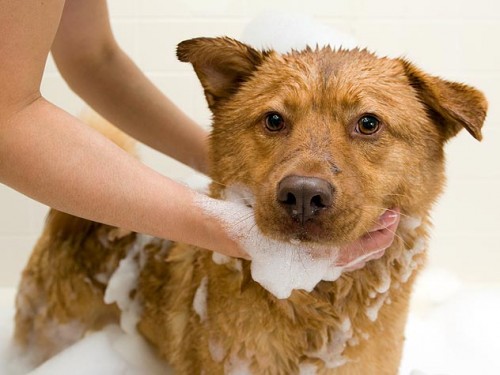
GETTING (FIDO) READY
Trimming your pet’s nails prior to bath time will not only give your dog better footing, it will also help protect your skin in case he tries to make a break for it. Now, bring the dog into the bathroom and close the door behind you — catching a wet, soapy dog running down your hallway is no easy task! Give praise and treats to make him comfortable in the bathroom before you try to get him into the tub. If you’re able to, gently putting a cotton ball in each ear can help keep water out — just be sure to remove them when you’re finished! Also, to help keep shampoo from irritating his eyes, you can put a drop of mineral oil in each one.
BRING ON THE SUDS
Dogs are unlikely to get into the tub willingly. For bigger dogs, a second person to help you get Fido into the bath can help avoid straining your back. Make sure water isn’t too hot or too cold. Let your dog hear and then gently feel the water before going full-speed ahead with the bath. Start shampooing your dog’s shoulders and then move out from there. Be gentle around the face and any sensitive areas but be sure you get down to the undercoat. Read the directions on the shampoo bottle carefully to ensure proper usage. Rinse out all the shampoo, using your fingers to make sure you get through the undercoat to avoid subsequent irritation. This is where a detachable showerhead or bowl comes in handy to be sure bigger dogs get rinsed thoroughly.
NO MORE TANGLES
After the shampoo has been completely rinsed out, you can apply conditioner, if desired. Follow the directions on the bottle because some products need to sit on the coat for several minutes. If you have a particularly squirmy dog, you’ll want to find a fast-acting formula. Once you have finished the bath, it is time to dry your pooch. Towel dry as much as possible in the bathroom. For dogs with longer coats, you may want to use a blow dryer set on low. Before the dog leaves the bathroom, brush his coat out thoroughly because the bath will loosen up a lot of fur, which is better contained in the bathroom than all over the house. Many dogs get “after-bath-crazies,” so hold onto your hat and let ‘em run!
Dog Skin Conditions: Allergies
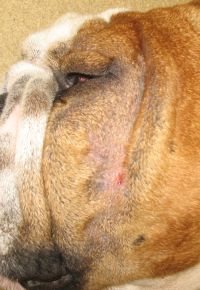
Atopy Flea allergy dermatitis
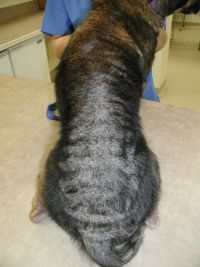
Photos courtesy David A. Senter, DVM
Cause: Inhaled substances such as dust mites and pollens (atopy or allergic inhalant dermatitis, an inherited condition); flea saliva (flea allergy dermatitis); contact with or ingestion of a triggering substance, including food ingredients.
Symptoms: Itching (often severe); skin rashes ranging from slight reddening to generalized inflammation with assorted bumps, pimples, and welt-like lesions; persistent ear infections. Secondary infections by bacteria and yeasts are common.
Treatment: Allergen avoidance, flea control, antihistamines, corticosteroids (“cortisone”), cyclosporine, and hyposensitization (“allergy shots”). Antibiotics and anti-yeast medications are used to treat secondary infections. Often a combination of therapies produces the best results.
Disclaimer: DogChannel.com’s Dog Skin Conditions are intended for educational purposes only. They are not meant to replace the expertise and experience of a professional veterinarian. Do not use the information presented here to make decisions about your dog’s ailment. If you notice changes in your dog’s health or behavior, please take your pet to the nearest veterinarian or an emergency pet clinic as soon as possible.
Doggie Biscotti
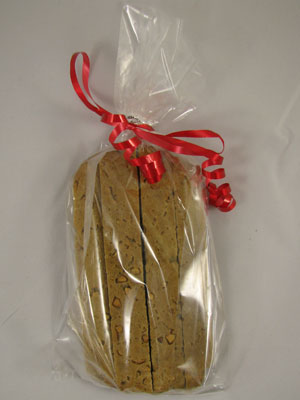
The recipe was provided Harvey Morris, creator of the Baked Chicago blog. Harvey first created this recipe over 10 years ago for his black pugs, Buddy and Rhoda. It was one of their favorite dog treats. Harvey was inspired to use human-grade ingredients because he wanted to feed his dogs unprocessed foods that were good for them – and he had 13 nieces / nephews who were (at that time) under the age of 18. Many of the toddlers were known to share their treats with the Pugs and even drop them on the floor when they were no longer hungry. If that happened with the biscotti, it didn’t matter if a dog or another kid picked it up and ate it!
Peanut Butter-Banana Biscotti, with Peanut Butter Cream Cheese-Yogurt Icing
For Biscotti:
4 cups all-purpose flour (we used gluten free flour and it worked great too)
½ teaspoon baking soda
1 cup crunchy peanut butter
3 bananas, pureed
1 cup water
¼ cup vegetable oil
1 egg
1 tablespoon vanilla
For Icing:
2 tablespoons creamy peanut butter
2 tablespoons plain yogurt
8 ounces cream cheese
3 tablespoons all-purpose flour
Steps to Make Doggie Biscotti
Preheat oven to 325F.
Place flour and baking soda in large bowl. Make a well in the center.
In another bowl, blend egg, vanilla, peanut butter, oil and banana together. Add into the well of the dry ingredients. Start combining together. Add water, one teaspoon at a time as needed.
Knead by hand on table until mixed thoroughly. Form into logs approximately 2″ in diameter. Flatten so that log is 6″ – 7″ wide by 1″ high. Place on baking sheets lined with parchment paper.
